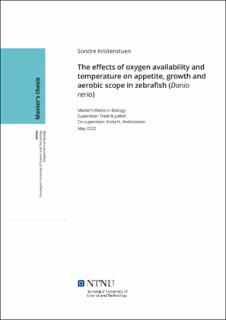The effects of oxygen availability and temperature on appetite, growth and aerobic scope in zebrafish (Danio rerio)
| dc.contributor.advisor | Jutfelt, Fredrik | |
| dc.contributor.advisor | Anna H. Andreassen | |
| dc.contributor.author | Kristenstuen, Sondre | |
| dc.date.accessioned | 2022-07-02T17:21:21Z | |
| dc.date.available | 2022-07-02T17:21:21Z | |
| dc.date.issued | 2022 | |
| dc.identifier | no.ntnu:inspera:104135638:23691713 | |
| dc.identifier.uri | https://hdl.handle.net/11250/3002417 | |
| dc.description.abstract | I en verden preget av ekstreme hetebølger trues artsmangfoldet og biodiversiteten. Temperatur påvirker biologien til ektoterme dyr drastisk, hvorav fisk direkte blir påvirket av vanntemperatur. En rekke hypoteser tar for seg evnen fisk har til å supplere vev med oksygen ved økende temperatur. Resultater fra tidligere studier fremhever kapasitetsbegrensninger ved oksygentransport ved økende temperaturer resulterende i redusert somatisk vekst. I dette studiet har vi undersøkt om oksygennivå (50%, 100% og 200% luftmetning) er en begrensende faktor for appetitt, vekst og aerob kapasitet i sebrafisk akklimert til 20° C og 34° C. Vår hypotese var at hypoksi ville redusere og hyperoksi øke prestasjonen med større effekt i varm akklimasjon siden metabolisme og oksygenopptak øker ved høyere temperatur. Vi fant at hyperoksi ledet til redusert appetitt ved høy temperatur og ingen effekt av oksygennivå i lave temperaturer. I tillegg fant vi at aerob kapasitet begrenset appetitt og vekst og at varmeakklimerte fisk presterte dårligere ved både hypoksi og hyperoksi. Vi fant også at vekstrate korrelerer med aerob kapasitet ved høye temperaturer som understreker fordelen med effektiv oksygentransport ved suboptimale temperaturer. Det viser seg at effekten av oksygennivå er avhengig av temperatur og vi støtter ideen om at økende temperatur setter begrensninger for optimal fysiologisk funksjon. | |
| dc.description.abstract | Species diversity and abundance are currently being threatened by extreme heat waves in a world of drastic climate change. Temperature has a dramatic effect on the biology of ectothermic animals, with fishes being directly affected by changes in water temperature. A variety of present hypotheses concerns the ability of fishes to supply tissue with oxygen with increasing temperature. Results from previous studies highlights the mechanistical constraint in capacity to deliver oxygen with increasingly supra-optimal temperatures, leading to reduced growth. In this study, we investigated whether ambient oxygen level (50 %, 100 % and 200 % air saturation) is a limiting factor for appetite, growth and aerobic scope in zebrafish acclimated to 20 °C and 34 °C. We hypothesized that hypoxia would reduce and hyperoxia increase these performances with a greater effect in warm acclimation, as metabolism and O_2-requirement are accelerated with increasing temperature. We found hyperoxia leading to reduced appetite in warm acclimation, and no effect of oxygen level in cold acclimation. We also found that aerobic scope was setting the limits for appetite and growth, and that warm acclimated fish tended to have reduced performance with both hypoxia and hyperoxia. Furthermore, we found growth rate to correlate with aerobic scope in warm acclimation, highlighting the benefit of having a higher oxygen transport capacity at supra-optimal temperatures. In general, the effect of oxygen was dependent on acclimation temperature, and we support the idea of fishes experiencing capacity limitation with increasing temperature, approaching “functional ceilings”. | |
| dc.language | eng | |
| dc.publisher | NTNU | |
| dc.title | The effects of oxygen availability and temperature on appetite, growth and aerobic scope in zebrafish (Danio rerio) | |
| dc.type | Master thesis |
Tilhørende fil(er)
Denne innførselen finnes i følgende samling(er)
-
Institutt for biologi [2604]
